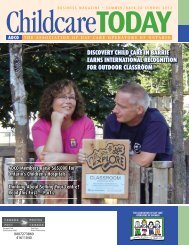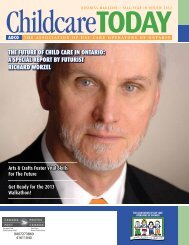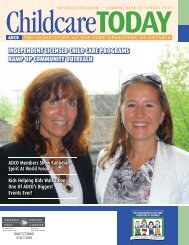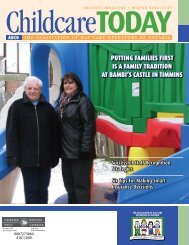Download - ADCO :: The Association of Day Care Operators of Ontario
Download - ADCO :: The Association of Day Care Operators of Ontario
Download - ADCO :: The Association of Day Care Operators of Ontario
Create successful ePaper yourself
Turn your PDF publications into a flip-book with our unique Google optimized e-Paper software.
PO BOX 208, Foxboro ON K0K 2B0<br />
Kathy Graham, CEO<br />
admin@adco-o.on.ca<br />
Tel: 613-395-6111<br />
Toll Free: 800.567.7075<br />
Fax: 613.395.6223<br />
For Release May 8, 2006<br />
Non-pr<strong>of</strong>it vs. for-pr<strong>of</strong>it child care debate a disservice to Canadian families, says <strong>Association</strong> <strong>of</strong> <strong>Day</strong><br />
<strong>Care</strong> <strong>Operators</strong> <strong>of</strong> <strong>Ontario</strong><br />
Functional and efficient daycare system must include for-pr<strong>of</strong>it and non-pr<strong>of</strong>it centres; federal child care tax credit<br />
program should be opened up to all sectors<br />
Greg Humphreys, president <strong>of</strong> the <strong>Association</strong> <strong>of</strong> <strong>Day</strong> <strong>Care</strong> <strong>Operators</strong> <strong>of</strong> <strong>Ontario</strong>, today released a new research<br />
paper: “Child CARE: Improving child care services for Canadian families” that dispels the myth <strong>of</strong> superiority<br />
surrounding non-pr<strong>of</strong>it child care and makes the case for equal treatment <strong>of</strong> the licensed for-pr<strong>of</strong>it daycare sector.<br />
‘<strong>The</strong> evidence shows that both non-pr<strong>of</strong>it and for-pr<strong>of</strong>it operators are capable <strong>of</strong> providing high-quality child care,”<br />
said Humphreys. <strong>The</strong>se findings contrast with the arguments made by many vocal national child care advocates who<br />
promote a heavily-unionized, non-pr<strong>of</strong>it model <strong>of</strong> child care for Canada.<br />
<strong>The</strong> research paper investigates the role <strong>of</strong> non-pr<strong>of</strong>it and for-pr<strong>of</strong>it child care centres in Canada and around the<br />
world. <strong>The</strong> work highlights four key advantages arising from the participation <strong>of</strong> the for-pr<strong>of</strong>it sector in any country’s<br />
child care program. <strong>The</strong>se CARE factors are:<br />
Choice: <strong>The</strong> inclusion <strong>of</strong> the licensed for-pr<strong>of</strong>it sector increases the range <strong>of</strong> choices that families have in<br />
selecting child care. Most families are uninterested in the ideological distinction between for-pr<strong>of</strong>it and nonpr<strong>of</strong>it<br />
care.<br />
Access: Restricting the provision <strong>of</strong> child care services to non-pr<strong>of</strong>it only, as is the case in Saskatchewan<br />
and is a policy objective in Toronto, will inevitably result in reduced access to regulated daycare for children.<br />
Responsiveness: Jurisdictions that treat licensed for-pr<strong>of</strong>it and non-pr<strong>of</strong>it child cares equally in terms <strong>of</strong><br />
government subsidies and other programs have found that the licensed for-pr<strong>of</strong>it sector is best able to<br />
respond quickly to increased demand.<br />
Efficiency: Jurisdictions that treat licensed for-pr<strong>of</strong>it and non-pr<strong>of</strong>it child care operators equally display<br />
lower costs per regulated child care space than do jurisdictions that discriminate.<br />
“As a daycare operator, I know that accessibility is a big issue with Canadian families,” says Humphreys, who<br />
operates two Alpha Child <strong>Care</strong> Centres in Brampton, <strong>Ontario</strong> with space for 185 children. “But one <strong>of</strong> the biggest<br />
problems in terms <strong>of</strong> creating new child care spaces is the fact that many provincial and municipal governments<br />
actively discriminate against the licensed for-pr<strong>of</strong>it sector. If we are going to solve the accessibility problem,<br />
governments need to recognize the benefits <strong>of</strong> licensed for-pr<strong>of</strong>it child care.”<br />
...2<br />
Proud affiliate <strong>of</strong> the Canadian Child <strong>Care</strong> Management <strong>Association</strong> & the Canadian Child <strong>Care</strong> Federation
PO BOX 208, Foxboro ON K0K 2B0<br />
Kathy Graham, CEO<br />
admin@adco-o.on.ca<br />
Tel: 613-395-6111<br />
Toll Free: 800.567.7075<br />
Fax: 613.395.6223<br />
Humphreys noted that these observations were particularly timely given the federal government’s proposed<br />
Community Childcare Investment Program. This $250 million per year program will provide tax credits <strong>of</strong> up to<br />
$10,000 for each new child care space directly created by an employer or in partnership with non-pr<strong>of</strong>it community<br />
associations. It is anticipated that 25,000 new spaces per year will be created through these tax credits over five<br />
years.<br />
However, given the advantages associated with licensed for-pr<strong>of</strong>it daycare delivery, Humphreys emphasized the<br />
necessity for making these tax credits available to all daycare operators. When the Netherlands used an employer<br />
tax credit system to triple the size <strong>of</strong> its child care system in the 1990s, the licensed for-pr<strong>of</strong>it sector was a major<br />
participant.<br />
“If the Conservative government is interested in providing choices to parents, then it makes sense to open up the<br />
Community Childcare Investment Program to all child care providers,” Humphreys added. “<strong>The</strong> for-pr<strong>of</strong>it sector is<br />
ready and willing to create more high-quality spaces for Canadian children. Even low cost loans, as found in Nova<br />
Scotia, would open the doors and help create not only more spaces but a renewable pool <strong>of</strong> money for continued<br />
expansion.”<br />
<strong>The</strong> <strong>Association</strong> <strong>of</strong> <strong>Day</strong> <strong>Care</strong> <strong>Operators</strong> <strong>of</strong> <strong>Ontario</strong> represents a wide range <strong>of</strong> child care providers in <strong>Ontario</strong>. Its<br />
membership includes licensed centre-based and home child care agencies, and it represents for-pr<strong>of</strong>it, non-pr<strong>of</strong>it,<br />
independent and franchised child care centres. <strong>ADCO</strong> members provide care for over 75,000 children on a daily<br />
basis. Its members have made equal funding between sectors and parental choice in child care key policy objectives<br />
both in <strong>Ontario</strong> and nationwide.<br />
For more information, contact:<br />
Greg Humphreys<br />
President, <strong>ADCO</strong><br />
905.584.4358<br />
Kathy Graham<br />
CEO, <strong>ADCO</strong><br />
613.395.6111<br />
Peter Shawn Taylor<br />
Author <strong>of</strong> the Child CARE report<br />
519.884.7692<br />
Proud affiliate <strong>of</strong> the Canadian Child <strong>Care</strong> Management <strong>Association</strong> & the Canadian Child <strong>Care</strong> Federation











